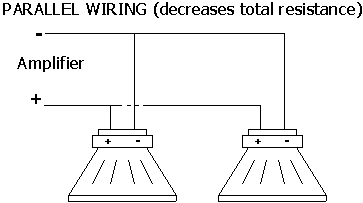Wiring
- A quick lesson in Physics.
A
simple way to get more power out of amplifiers is
to wire speakers in different ways, playing with
resistances to achieve a desired total impedance
as "seen" by the amplifier. Even though speakers
are active loads i.e. resistance changes
with frequency, it is accepted to consider speakers
as resistors with a fixed resistance value (usually
4 ohms). By combining speakers in different ways,
maximum amplifier output can be obtained.
Parallel
Resistance

People
commonly connect two or more speakers to the same
channel out of an amplifier in parallel. This is
achieved by connecting the negative wire from the
amplifier to all the negative connections of the
speakers, and the positive to all the positive connections
of the speakers. By doing this, the load seen by
the amplifier is lower. For example, if two 4-ohm
speakers are wired-up in parallel, then their total
resistance will be half, or 2 ohms. If three speakers
are wired up in parallel, and they all have the
same resistance value, then the total load would
be a third of the value of each speaker's resistance.
Here's a formula to calculate parallel total resistance
for two speakers:

For more than two speakers, use the following formula:

One plus on using this is that if one of the speakers
burns out, then the other one(s) keep playing. If
the amplifier however is not designed to receive
lower loads provided by connecting the speakers
up in this fashion, you might end up destroying
your amplifier. Check your manual or consult an
expert before experimenting.
Series
Resistance

Speakers that are connected in series, decrease
total load to an amplifier. To connect speakers
in series, connect the positive terminal of the
amplifier to the positive of one speaker, then hook
up negative of that speaker to positive of next
speaker, and so on. Then connect the negative of
last speaker to negative of the amplifier. It is
a lot easier to calculate total resistance for speakers
connected in series. This is easily done by adding
up all the individual resistances as seen in the
formula below:

other
than getting less power out of an amplifier, if
one of the speakers burns up, the other one(s) stop
working thus this is not a preferred choice when
connecting subs.
Drawings
courtesy A' Level Physics - Burt & Lancaster